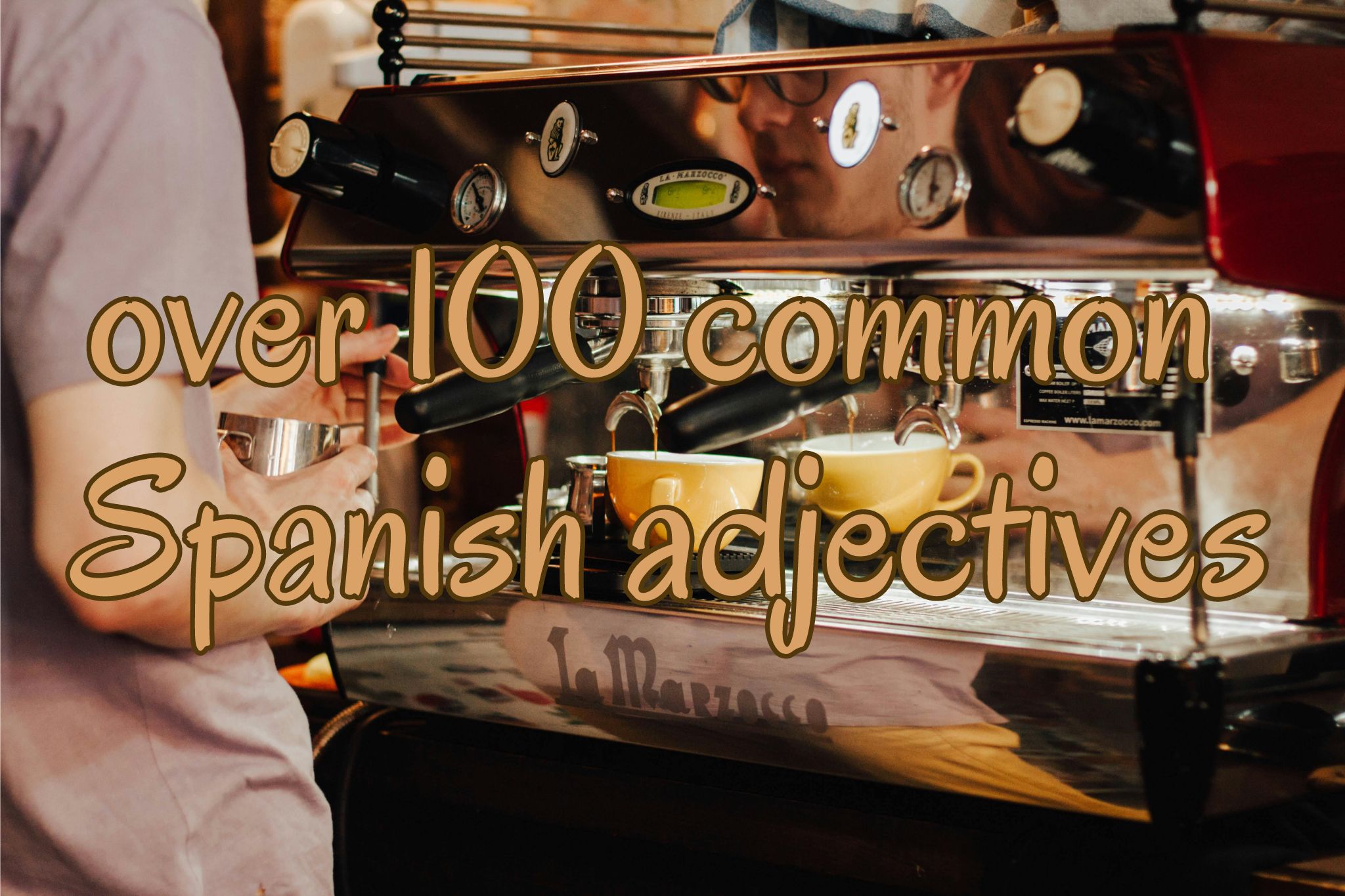List: Over 100 Basic Spanish Adjectives, in every form

Get our free email course, Shortcut to Conversational.
Have conversations faster, understand people when they speak fast, and other tested tips to learn faster.
More infoAre you looking for a list of Spanish adjectives? Well, you’ve come to the right place, because in this post we present more than 100 of the most common Spanish adjectives!
We’ll start with a quick overview of how Spanish adjectives work, touching on both gender agreement and sentence placement. Then we’ll get straight into our lists of basic Spanish adjectives! For each one, we provide each of its possible forms to reflect gender and number, along with the English translation.
This post has gotten a huge update since it was originally published, with our Spanish adjectives list growing fourfold. If you’re coming back here to review what you saw before, we’re sure you’ll be pleased with all the additional vocab. Now let’s dive in!
Spanish adjectives 101
An adjective is a word that describes, identifies, modifies, or quantifies a noun. The two main rules we need to know about Spanish adjectives pertain to gender and number agreement, and sentence structure.
There are several categories of adjectives, but the ones we think of most are the describing words in Spanish. All the vocabulary words we introduce in this post fall into this category of Spanish descriptive adjectives.
We have a detailed post explaining how to use adjectives in Spanish, so head there for a full lesson on descriptive adjectives and more. We’ll just cover the essential grammar rules here before we get into our lists of Spanish adjectives.
Gender and number agreement
Since all Spanish nouns are either masculine or feminine, all Spanish adjectives have masculine and feminine forms to match. Using the right form of a given adjective for a given noun is called gender agreement, and it’s a fundamental rule for Spanish adjectives. Most adjectives end -o in masculine and end in -a in feminine, with corresponding plural endings -os and -as. These endings match the plural indefinite articles: unos and unas.
Some Spanish adjectives are invariable, which means they have only one form that we use in both masculine and feminine. Invariable adjectives in Spanish end in letters other than -o.
When nouns are plural, the Spanish adjectives that modify them need to take a plural form too. For most adjectives this just involves adding an -s, though some of the invariable adjectives follow other Spanish pluralization rules.
The masculine singular form of a Spanish adjective is considered its default form, so you’ll often only see this one in vocab lists or dictionary entries. Just remember that most adjectives still have four distinct forms: masculine singular, feminine singular, masculine plural, and feminine plural. For example, here are the four forms of the adjective bueno, meaning good:
- bueno (masculine singular)
- buena (feminine singular)
- buenos (masculine plural)
- buenas (feminine plural)
For invariable adjectives, there are just two forms. Let’s see this in action with the adjective caliente, meaning hot:
- caliente (masculine singular, feminine singular)
- calientes (masculine plural, feminine plural)
In our lists of Spanish adjectives below, we include all four forms for every adjective. The invariable adjectives are in their own list with their two forms.
Word order for Spanish adjectives
One of the main differences to English is that in Spanish, the adjective usually goes after the noun. This may take a bit of getting used to if you’re new to the language, but you’ll get the hang of it pretty quickly.
We place the adjective after the noun whether it’s directly modifying it, or if the adjective comes after a conjugated verb.
- Preparé dos cafés calientes. – I prepared two hot coffees.
- Los cafés están calientes. – The coffees are hot.
There are some exceptions to this rule, but you can’t really go wrong if you just stick with the norm and always place the Spanish adjective after the noun. We cover the exceptions in our companion post on grammar rules for adjectives in Spanish.
Adjectives in Spanish: examples
Before we get into our big list of Spanish adjectives, let’s just see some examples where we apply the rules we’ve just learned. Watch as BaseLang teacher Melissa uses each one, or read on to see them all in action.
We’ll start off with a set of regular adjectives in Spanish that change form to match the gender and number of the noun. From the default (masculine singular) form we provide before each example, see how these variable adjectives then end in -o, -a, -os, or -as once they’re placed after their nouns.
- bueno: Un hotel bueno. (masculine singular) – A good hotel.
- malo: Un televisor malo. (masculine singular) – A bad television.
- aburrido: Una una película aburrida. (feminine singular) – A boring film.
- nuevo: Una calle nueva. (feminine singular) – A new street.
- pequeño: Los gatos pequeños. (masculine plural) – The small cats.
- viejo: Unos taxis viejos. (masculine plural) – Some old taxis.
- delicioso: Unas manzanas deliciosas. (feminine plural) – Some delicious apples.
- divertido: Las clases divertidas. (feminine plural) – The fun classes.
Now we’ll show some invariable adjectives. Note that the masculine and feminine forms are identical, so they just change form between singular and plural.
- fácil: Un trabajo fácil. (masculine singular) – An easy job.
- feliz: Una familia feliz. (feminine singular) – A happy family.
- difícil: Unos días difíciles. (masculine plural) – Some difficult days.
- triste: Las niñas tristes. (feminine plural) – The sad girls.
Ok, now that we’re clear on the fundamental rules for using Spanish descriptive adjectives, let’s get into our vocab lists!
Spanish adjectives list
Here we present the most common Spanish adjectives that you should know. These are all descriptive adjectives, so you’ll find the perfect Spanish adjectives to describe a person, a place, or a thing.
We don’t include colors, since we cover them in a dedicated post on colors in Spanish. We also recommend our related posts on making physical descriptions, body parts, describing how you feel, and giving compliments.
In this first list of adjectives in Spanish we provide all four forms of each one, along with the English translation. We provide a second list of invariable adjectives below.
| English | Masculine singular | Feminine singular | Masculine plural | Feminine plural |
| open | abierto | abierta | abiertos | abiertas |
| sour | agrio | agria | agrios | agrias |
| sharp | agudo | aguda | agudos | agudas |
| tall | alto | alta | altos | altas |
| bitter | amargo | amarga | amargos | amargas |
| wide | ancho | ancha | anchos | anchas |
| unfriendly | antipático | antipática | antipáticos | antipáticas |
| rough | áspero | áspera | ásperos | ásperas |
| cheap | barato | barata | baratos | baratas |
| beautiful | bello | bella | bellos | bellas |
| soft | blando | blanda | blandos | blandas |
| good | bueno | buena | buenos | buenas |
| expensive | caro | cara | caros | caras |
| married | casado | casada | casados | casadas |
| near | cercano | cercana | cercanos | cercanas |
| closed | cerrado | cerrada | cerrados | cerradas |
| light (color), clear | claro | clara | claros | claras |
| cooked | cocido | cocida | cocidos | cocidas |
| comfortable | cómodo | cómoda | cómodos | cómodas |
| complicated | complicado | complicada | complicados | complicadas |
| correct | correcto | correcta | correctos | correctas |
| short | corto | corta | cortos | cortas |
| raw | crudo | cruda | crudos | crudas |
| curved | curvado | curvada | curvados | curvadas |
| thin | delgado | delgada | delgados | delgadas |
| right | derecho | derecha | derechos | derechas |
| unknown | desconocido | desconocida | desconocidos | desconocidas |
| hard | duro | dura | duros | duras |
| sick | enfermo | enferma | enfermos | enfermas |
| whole | entero | entera | enteros | enteras |
| narrow | estrecho | estrecha | estrechos | estrechas |
| fake, false | falso | falsa | falsos | falsas |
| famous | famoso | famosa | famosos | famosas |
| ugly | feo | fea | feos | feas |
| cold | frío | fría | fríos | frías |
| generous | generoso | generosa | generosos | generosas |
| thick | grueso | gruesa | gruesos | gruesas |
| unclear | incierto | incierta | inciertos | inciertas |
| uncomfortable | incómodo | incómoda | incómodos | incómodas |
| incorrect | incorrecto | incorrecta | incorrectos | incorrectas |
| unfair | injusto | injusta | injustos | injustas |
| unnecessary | innecesario | innecesaria | innecesarios | innecesarias |
| intelligent | inteligente | inteligente | inteligentes | inteligentes |
| left | izquierdo | izquierda | izquierdos | izquierdas |
| fair | justo | justa | justos | justas |
| long | largo | larga | largos | largas |
| distant | lejano | lejana | lejanos | lejanas |
| slow | lento | lenta | lentos | lentas |
| light | ligero | ligera | ligeros | ligeras |
| clean | limpio | limpia | limpios | limpias |
| full | lleno | llena | llenos | llenas |
| bad | malo | mala | malos | malas |
| wet | mojado | mojada | mojados | mojadas |
| dead | muerto | muerta | muertos | muertas |
| necessary | necesario | necesaria | necesarios | necesarias |
| new | nuevo | nueva | nuevos | nuevas |
| blunt | obtuso | obtusa | obtusos | obtusas |
| busy | ocupado | ocupada | ocupados | ocupadas |
| proud | orgulloso | orgullosa | orgullosos | orgullosas |
| dark | oscuro | oscura | oscuros | oscuras |
| dangerous | peligroso | peligrosa | peligrosos | peligrosas |
| small | pequeño | pequeña | pequeños | pequeñas |
| heavy | pesado | pesada | pesados | pesadas |
| flat | plano | plana | planos | planas |
| private | privado | privada | privados | privadas |
| deep | profundo | profunda | profundos | profundas |
| public | público | pública | públicos | públicas |
| fast | rápido | rápida | rápidos | rápidas |
| straight | recto | recta | rectos | rectas |
| round | redondo | redonda | redondos | redondas |
| rich | rico | rica | ricos | ricas |
| broken | roto | rota | rotos | rotas |
| noisy | ruidoso | ruidosa | ruidosos | ruidosas |
| salty | salado | salada | salados | saladas |
| healthy | sano | sana | sanos | sanas |
| dry | seco | seca | secos | secas |
| safe | seguro | segura | seguros | seguras |
| quiet | silencioso | silenciosa | silenciosos | silenciosas |
| single | soltero | soltera | solteros | solteras |
| dirty | sucio | sucia | sucios | sucias |
| stingy | tacaño | tacaña | tacaños | tacañas |
| early | temprano | temprana | tempranos | tempranas |
| empty | vacío | vacía | vacíos | vacías |
| true | verdadero | verdadera | verdaderos | verdaderas |
| old | viejo | vieja | viejos | viejas |
| alive | vivo | viva | vivos | vivas |
This next list of Spanish adjectives only has two columns because they don’t change form between masculine and feminine. These are the most common invariable adjectives in Spanish. Keep in mind that some of the plural forms take slightly different endings than simply adding -s.
| English | Singular | Plural |
| friendly | amigable | amigables |
| absent | ausente | ausentes |
| bright | brillante | brillantes |
| hot | caliente | calientes |
| weak | débil | débiles |
| difficult | difícil | difíciles |
| sweet | dulce | dulces |
| exterior | exterior | exteriores |
| easy | fácil | fáciles |
| happy | feliz | felices |
| strong | fuerte | fuertes |
| big | grande | grandes |
| humble | humilde | humildes |
| impossible | imposible | imposibles |
| interior | interior | interiores |
| useless | inútil | inútiles |
| young | joven | jóvenes |
| free | libre | libres |
| spicy | picante | picantes |
| poor | pobre | pobres |
| possible | posible | posibles |
| present | presente | presentes |
| real | real | reales |
| simple | simple | simples |
| smooth | suave | suaves |
| shallow | superficial | superficiales |
| late | tarde | tardes |
| sad | triste | tristes |
| useful | útil | útiles |
Conclusion: Basic Spanish adjectives
Today we introduced over 100 of the most common Spanish adjectives that every learner should know.
We started off with a brief overview of the grammar rules pertaining to Spanish adjectives.
The first rule is that they need to agree in gender and number with the nouns they modify, though a subset of invariable adjectives only changes form between singular and plural. Thus, most Spanish adjectives have four distinct forms, while the invariable adjectives have two forms.
The second rule is that Spanish adjectives usually come after their nouns. This is a basic rule of Spanish sentence structure that you should get used to pretty quickly.
Once we demonstrated these two rules with a handful of examples, we got into our vocab. First we provided a list of Spanish adjectives that take four unique forms, showing all four forms for each one. We finished off with a list of invariable Spanish adjectives, in which we showed both their singular and plural forms.
Between the big Spanish adjectives list from this post, and our other post with the full grammar lesson, you now have a great introduction to the most common Spanish adjectives!



